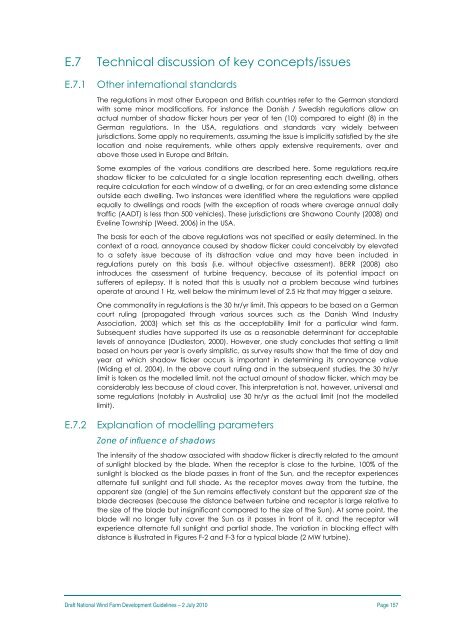Draft National Wind Farm Development Guidelines - July 2010
Draft National Wind Farm Development Guidelines - July 2010
Draft National Wind Farm Development Guidelines - July 2010
Create successful ePaper yourself
Turn your PDF publications into a flip-book with our unique Google optimized e-Paper software.
E.7 Technical discussion of key concepts/issues<br />
E.7.1<br />
Other international standards<br />
The regulations in most other European and British countries refer to the German standard<br />
with some minor modifications. For instance the Danish / Swedish regulations allow an<br />
actual number of shadow flicker hours per year of ten (10) compared to eight (8) in the<br />
German regulations. In the USA, regulations and standards vary widely between<br />
jurisdictions. Some apply no requirements, assuming the issue is implicitly satisfied by the site<br />
location and noise requirements, while others apply extensive requirements, over and<br />
above those used in Europe and Britain.<br />
Some examples of the various conditions are described here. Some regulations require<br />
shadow flicker to be calculated for a single location representing each dwelling, others<br />
require calculation for each window of a dwelling, or for an area extending some distance<br />
outside each dwelling. Two instances were identified where the regulations were applied<br />
equally to dwellings and roads (with the exception of roads where average annual daily<br />
traffic (AADT) is less than 500 vehicles). These jurisdictions are Shawano County (2008) and<br />
Eveline Township (Weed, 2006) in the USA.<br />
The basis for each of the above regulations was not specified or easily determined. In the<br />
context of a road, annoyance caused by shadow flicker could conceivably by elevated<br />
to a safety issue because of its distraction value and may have been included in<br />
regulations purely on this basis (i.e. without objective assessment). BERR (2008) also<br />
introduces the assessment of turbine frequency, because of its potential impact on<br />
sufferers of epilepsy. It is noted that this is usually not a problem because wind turbines<br />
operate at around 1 Hz, well below the minimum level of 2.5 Hz that may trigger a seizure.<br />
One commonality in regulations is the 30 hr/yr limit. This appears to be based on a German<br />
court ruling (propagated through various sources such as the Danish <strong>Wind</strong> Industry<br />
Association, 2003) which set this as the acceptability limit for a particular wind farm.<br />
Subsequent studies have supported its use as a reasonable determinant for acceptable<br />
levels of annoyance (Dudleston, 2000). However, one study concludes that setting a limit<br />
based on hours per year is overly simplistic, as survey results show that the time of day and<br />
year at which shadow flicker occurs is important in determining its annoyance value<br />
(Widing et al, 2004). In the above court ruling and in the subsequent studies, the 30 hr/yr<br />
limit is taken as the modelled limit, not the actual amount of shadow flicker, which may be<br />
considerably less because of cloud cover. This interpretation is not, however, universal and<br />
some regulations (notably in Australia) use 30 hr/yr as the actual limit (not the modelled<br />
limit).<br />
E.7.2<br />
Explanation of modelling parameters<br />
Zone of influence of shadows<br />
The intensity of the shadow associated with shadow flicker is directly related to the amount<br />
of sunlight blocked by the blade. When the receptor is close to the turbine, 100% of the<br />
sunlight is blocked as the blade passes in front of the Sun, and the receptor experiences<br />
alternate full sunlight and full shade. As the receptor moves away from the turbine, the<br />
apparent size (angle) of the Sun remains effectively constant but the apparent size of the<br />
blade decreases (because the distance between turbine and receptor is large relative to<br />
the size of the blade but insignificant compared to the size of the Sun). At some point, the<br />
blade will no longer fully cover the Sun as it passes in front of it, and the receptor will<br />
experience alternate full sunlight and partial shade. The variation in blocking effect with<br />
distance is illustrated in Figures F-2 and F-3 for a typical blade (2 MW turbine).<br />
<strong>Draft</strong> <strong>National</strong> <strong>Wind</strong> <strong>Farm</strong> <strong>Development</strong> <strong>Guidelines</strong> – 2 <strong>July</strong> <strong>2010</strong> Page 157
















